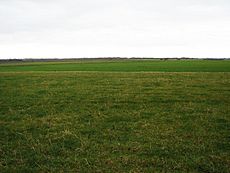Burreth, Lincolnshire facts for kids

Burreth (sometimes called Burgrede) is a village in Lincolnshire, England, that no longer exists. It was once a busy medieval village but became deserted a long time ago. Today, you can only see its remains through special studies of the land.
Life in Medieval Burreth
Burreth was first written about in the Domesday Book. This was a huge survey of England made in 1086. The village was located in what is now the East Lindsey area of Lincolnshire.
In the late 1200s, a powerful lord named Robert de Neville owned the land of Burreth. He held it from even more powerful people, like the Earl of Lincoln and the Bishop of Lincoln. This system of land ownership was called Manorialism.
By 1377, a special tax called the poll tax was collected. Records show that 74 people in Burreth were old enough to pay this tax. The village paid £1 4s 8d, which was a good amount of money back then.
Burreth had its own church, dedicated to St Peter. It was connected to Tupholme Abbey, a local monastery. The last priest of Burreth's church died in 1349. This was during the time of the Black Death, a terrible plague that swept across Europe. While the Black Death caused many deaths, it didn't always make villages disappear completely. Many villages like Burreth became truly deserted later, in the 1400s. This happened when new farming methods and enclosures (fencing off land) encouraged people to move.
The village of Burreth was last recorded as existing in 1381. Even though the village is gone, its original church area is still part of the Tupholme parish today.
What Remains Today
If you look at Burreth from above, like in aerial photography, you can still see signs of the old village. These include earthworks (changes in the ground) and crop marks (patterns in crops that show buried features).
There are also remains of a moat, which is a ditch that often surrounded important buildings. Local stories say that a small hill or mound is where the church once stood. Experts from Historic England describe another area as "confused." This likely means it was where houses once were, but it has been damaged by old stone quarrying.
Archaeologists have found old stone, pottery, and tiles from the buildings. They have even found what might be the outline of the church, measuring about 16 meters (52 feet) by 9 meters (30 feet). Interestingly, Burreth was also home to at least one hermit in the 1200s. A hermit was someone who lived alone, often for religious reasons.
Archaeological Studies
The most recent detailed study of Burreth was carried out in 1964. Since then, more farming and ploughing have taken place. This has made it harder to find and study the remains of the village today.


